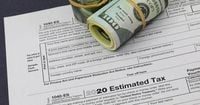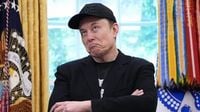For decades, Americans have debated whether the country’s richest citizens truly pay their fair share in taxes. Now, a groundbreaking new study by a team of UC Berkeley economists has put hard numbers to this perennial question, revealing a tax landscape that favors the ultra-wealthy in ways few could have imagined.
The study, conducted by Akcan Balkir, Emmanuel Saez, Danny Yagan, and Gabriel Zucman, analyzed the financial realities of the Forbes 400—the 400 wealthiest Americans, a group whose minimum net worth reached $3.3 billion in 2025. This elite cohort, including household names like Elon Musk, Jeff Bezos, Larry Ellison, and Donald Trump, collectively commands a staggering share of the nation’s wealth. According to the research, the top 400 now own 4.1 percent of all U.S. wealth, up from just 0.9 percent in 1982. Their fortunes now equal about 20 percent of America’s gross domestic product, a dramatic leap from 2 percent four decades ago, as reported by the National Bureau of Economic Research (NBER).
But it’s not just the scale of their wealth that’s turning heads—it’s how little of it they surrender to the taxman. The study found that from 2018 through 2020, these billionaires paid an average effective tax rate of just 23.8 percent. That’s a far cry from the 30 percent average paid by the rest of the U.S. population. For the top 100 richest Americans, the rate sinks even lower, to about 22 percent. The numbers are even more striking when compared to high-earning professionals who derive most of their income from wages: this group faces an effective tax rate of 45 percent, according to the Berkeley analysis cited by CBS MoneyWatch.
So, how do the ultra-wealthy manage to pay so little? The answer lies in the structure of their wealth and the intricacies of the U.S. tax code. Rather than earning traditional salaries, many billionaires receive compensation through shares in publicly traded companies, privately held businesses, and investments in so-called “pass-through” companies, which benefit from special tax rules. Mark Zuckerberg, for example, reportedly pays himself a $1 base salary at Meta, with most of his compensation coming from other sources. This strategy allows the wealthy to report less taxable income, as much of their wealth is tied up in assets that only get taxed when sold—if ever.
Capital gains and business income are taxed at lower rates than wages. The highest tax rate on earned income sits at 37 percent, but long-term capital gains are taxed at just 20 percent, and corporate income at 21 percent. If the rich hold onto their investments and don’t sell, they can avoid realizing capital gains—and thus, avoid taxation altogether. “The billionaire class can avoid realizing individual income and hence can escape the individual income tax,” Emmanuel Saez told CBS MoneyWatch.
Adding to this advantage, the study found that the richest Americans and their accountants employ creative strategies to further reduce their tax bills. By reporting losses and exploiting deductions such as depreciation, these billionaires made their profitable businesses appear to be operating at a loss, reducing taxable income by an average of $33 million per year between 2018 and 2020. The effect was so pronounced, the researchers noted, that companies’ taxable income was “no longer a good measure” of their “true profits.”
Importantly, the new study doesn’t just tally up personal income taxes. It also includes corporate taxes paid by the companies these billionaires own, allocating a share of corporate taxes to owners like Jeff Bezos. “The economic income of the wealthiest are essentially the profits of the businesses they own,” Saez explained. “Jeff Bezos owns about 10% of Amazon, and hence his true economic income is 10% of Amazon’s profits.” This approach, the researchers argue, gives a more accurate picture of the true tax burden shouldered by the ultra-rich.
Yet, even with this broader accounting, the richest Americans still pay less, proportionally, than many millionaires and even some middle-class professionals. According to the NBER paper, corporate taxes make up about 9 percent of the 23.8 percent effective tax rate paid by the top 400, highlighting that individual income taxes alone don’t capture the full story.
What changed to make these disparities so stark? The answer, in large part, is policy. Before the passage of the Tax Cuts and Jobs Act (TCJA) in 2017, the richest Americans paid an effective tax rate of about 30 percent—roughly on par with the average American. But after the TCJA went into effect in 2018, their effective rate dropped sharply to 23.8 percent, a shift that has persisted in the years since. The TCJA lowered the corporate tax rate and restructured individual tax brackets, making it easier for the wealthy to shelter their fortunes.
And this trend shows no sign of reversing. The One Big Beautiful Bill Act, signed into law by President Trump on July 4, 2025, extended the TCJA’s tax cuts, created new business loopholes, and raised the estate-tax exemption to $15 million per person. According to The Atlantic and analysis by the nonpartisan Tax Foundation, these changes are likely to keep effective tax rates for the richest Americans at historic lows for years to come. While Republican proponents, such as House Speaker Mike Johnson, argue that these policies will boost the economy and provide relief to workers and families, critics point out that the revenue losses have been offset by cuts to health coverage and reductions in the Supplemental Nutrition Assistance Program for low-income Americans.
For some, the solution is clear. Saez and Zucman, both leading inequality researchers, are vocal supporters of instituting a wealth tax to address the growing chasm between the haves and have-nots. “The wealth tax is the most direct and powerful way to specifically target the ultra-rich and increase tax progressivity at the very top,” Saez told CBS MoneyWatch. The idea has found support among progressive lawmakers like Senators Elizabeth Warren and Bernie Sanders. However, conservative critics warn that such a tax could discourage entrepreneurship and investment, with the Hoover Institute arguing it might be self-defeating.
Despite the political wrangling, the data speaks for itself. The richest 400 Americans now control a larger slice of the national pie than ever before, yet their effective tax rates have plummeted. While the top 1 percent of earners do shoulder a significant share of the nation’s tax burden—about 40 percent of all federal individual income tax, according to the Tax Foundation—the ultra-wealthy are, on average, paying less than the typical American household.
The debate over how to tax the richest Americans is far from settled. But thanks to this new research, the facts are clearer than ever: at the very top, the tax code bends, and sometimes, it breaks.

